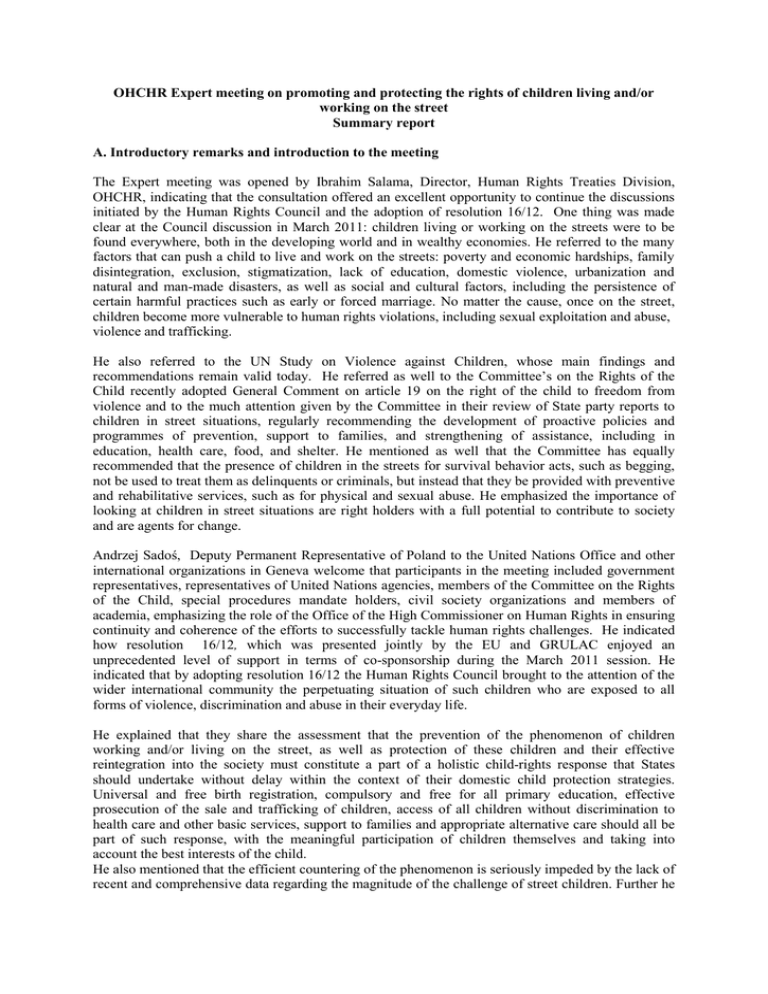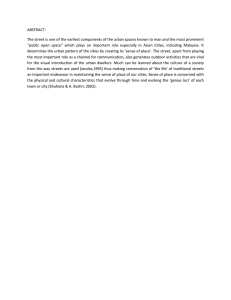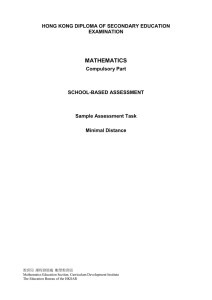OHCHR Expert meeting on promoting and protecting the rights of... working on the street
advertisement

OHCHR Expert meeting on promoting and protecting the rights of children living and/or working on the street Summary report A. Introductory remarks and introduction to the meeting The Expert meeting was opened by Ibrahim Salama, Director, Human Rights Treaties Division, OHCHR, indicating that the consultation offered an excellent opportunity to continue the discussions initiated by the Human Rights Council and the adoption of resolution 16/12. One thing was made clear at the Council discussion in March 2011: children living or working on the streets were to be found everywhere, both in the developing world and in wealthy economies. He referred to the many factors that can push a child to live and work on the streets: poverty and economic hardships, family disintegration, exclusion, stigmatization, lack of education, domestic violence, urbanization and natural and man-made disasters, as well as social and cultural factors, including the persistence of certain harmful practices such as early or forced marriage. No matter the cause, once on the street, children become more vulnerable to human rights violations, including sexual exploitation and abuse, violence and trafficking. He also referred to the UN Study on Violence against Children, whose main findings and recommendations remain valid today. He referred as well to the Committee’s on the Rights of the Child recently adopted General Comment on article 19 on the right of the child to freedom from violence and to the much attention given by the Committee in their review of State party reports to children in street situations, regularly recommending the development of proactive policies and programmes of prevention, support to families, and strengthening of assistance, including in education, health care, food, and shelter. He mentioned as well that the Committee has equally recommended that the presence of children in the streets for survival behavior acts, such as begging, not be used to treat them as delinquents or criminals, but instead that they be provided with preventive and rehabilitative services, such as for physical and sexual abuse. He emphasized the importance of looking at children in street situations are right holders with a full potential to contribute to society and are agents for change. Andrzej Sadoś, Deputy Permanent Representative of Poland to the United Nations Office and other international organizations in Geneva welcome that participants in the meeting included government representatives, representatives of United Nations agencies, members of the Committee on the Rights of the Child, special procedures mandate holders, civil society organizations and members of academia, emphasizing the role of the Office of the High Commissioner on Human Rights in ensuring continuity and coherence of the efforts to successfully tackle human rights challenges. He indicated how resolution 16/12, which was presented jointly by the EU and GRULAC enjoyed an unprecedented level of support in terms of co-sponsorship during the March 2011 session. He indicated that by adopting resolution 16/12 the Human Rights Council brought to the attention of the wider international community the perpetuating situation of such children who are exposed to all forms of violence, discrimination and abuse in their everyday life. He explained that they share the assessment that the prevention of the phenomenon of children working and/or living on the street, as well as protection of these children and their effective reintegration into the society must constitute a part of a holistic child-rights response that States should undertake without delay within the context of their domestic child protection strategies. Universal and free birth registration, compulsory and free for all primary education, effective prosecution of the sale and trafficking of children, access of all children without discrimination to health care and other basic services, support to families and appropriate alternative care should all be part of such response, with the meaningful participation of children themselves and taking into account the best interests of the child. He also mentioned that the efficient countering of the phenomenon is seriously impeded by the lack of recent and comprehensive data regarding the magnitude of the challenge of street children. Further he indicated that in order to successfully tackle this issue, national efforts should be supplemented by an enhanced international co-operation and coordination. Imma Guerras-Delgado, Human Rights Officer, OHCHR, explained how this process came about and the different components, which included a global research paper that had been produced by consultant Dr. Sarah Thomas de Benitez and a paper on children views being produced by Louise Meincke from the Consortium for Street Children. The expert meeting was another component to be able to gather further views from stakeholders in order to prepare the OHCHR report to the Council. Particular mention was made to AVIVA which supported this process, as well as the Consortium for Street Children and UNICEF. This was an excellent example of how to have a continuous discussion of a topic which was initiated during the Human Rights Council annual day of discussion on children rights. A call for submissions with more than 80 contributions, the consultant reports and this expert consultation will inform the HC’s report to the Council. B. Setting the scene: children in street situations Najat Maalla Majid, Special Rapporteur on sale of children, child prostitution and child pornography referred to the different terminologies being used, “street children”, “children in street, children of streets”, “children on the streets”, “children working and/or living on the street”, which have evolved with time, trying to embrace very diverse realities. Given the complexity of the phenomenon and the variety of situations covered, the expression “children in street situations”, seemed the most appropriate, referring to children living on the streets, whether occasionally or not, with or without their families, as well as those who work on streets and many others in similar situations. She explained that these children are not a homogenous group and many typologies can be identified according to gender, age, origin, migrant status, the mode of entry into the street, the mode of survival/life on the streets, amount of time spent on the streets, whether the child is street leader or not, etc… The common denominator among these children is that, for all of them, the street represents a point of reference. She underscored that every child is unique, and, consequently, there is a need to adopt a personalized and adapted approach. She referred to the global number which go to hundreds of millions and indicated that these estimates are challenged because of their approximate and unreliable nature, as they are not grounded on rigorous research methods. One also had to take into account the fact that numbers fluctuate, according to the socio-economic, political and sociocultural context and growing urbanization. In addition, an important part of children in street situation had never been registered and did not possess identity documents, leading to the lack of recognition of their legal personality and to their noninclusion in official statistics. After focussing on a number of push and pull factors, she stressed that children in street situations face discrimination, stigmatization, are deprived of their rights and have no access to education, health and protection. However, at the same time, on the streets, children develop also skills that have to be taken into account during the recovery and reintegration process. Bearing in mind the complexity of the phenomenon and the variety of situations it covers, there is a need to build comprehensive child protection systems, including targeted programs and services easily accessible to all these children, without discrimination and guaranteeing them the full enjoyment of all their rights. In her presentation Dr Sarah Thomas de Benitez, Senior International Consultant, discussed the preliminary findings from the Global Research paper, commissioned by the OHCHR for the consultation. She sought to highlight that a child’s multiple deprivations of their rights happen even before touching urban streets, for example through neglect and abuse in the home. By focusing on the ‘connections’ children build with the street it was emphasised that the child is a social actor eminently capable of developing relationships and forming attachments (alongside their connections to family and neighbours) to and within the street – and these have an unique influence on their identity development. ‘Street connectedness’ suggest that children start to develop or strengthen their connections with and within the street when other connections are weakened, temporarily fractured, chronically damaged or broken. She suggested that these children should be understood as children ‘for whom the street is a central reference point and which plays a significant role in their everyday lives and identities’. Although these children experience limited choices, it is significant that they still exercise agency in choosing to connect with the street. The term ‘street connectedness’ recognises the children’s agency in their own development, and understands right deprivations in a holistic context. Child Protection Systems take a holistic approach to service provision - which means that they are particularly interested in strengthening children’s relationships –or connections - with a range of ‘duty bearers’. She argued that this approach is therefore compatible with an understanding of children as connected to streets and families. It is imperative that children’s individual experiences are listened to, and children’s participation in research takes place to inform policy and intervention responses. Dr Thomas de Benitez emphasised the importance of States being supported in developing comprehensive Child Protection Systems criteria, good practices and data collection. Bulelwa Hewitt, Umthombo Street Children, took the opportunity to relay her personal experience of life on the street in South Africa, as a young girl of nine who ran away with her siblings from an abusive family and neighbours, and alcoholic mother. By the age of nine she had already been stabbed by an adult, raped by neighbors and burned in a shack fire. Whilst on the street she scavenged for food in rubbish dumps and misused drugs to numb the pain of her everyday life. Through the help of another street boy, she accessed a shelter with her siblings, and has now set up Umthombo street children project in Durban, South Africa. Looking back, she highlighted that it is not just poverty which pushes children to the street, but that something else on top pushes them there. She emphasized two messages: The first being that all street children are traumatized, and that any global strategy must create a path towards emotional healing. Street children need to be more than just a number, and emotional healing needs to continue beyond life on the streets. She urged policy makers to make the response to trauma a central part of strategies. Secondly, she laid emphasis on the practice of police round ups to clean the streets of street children. She urged that this practice of forced removals, in particular in the lead up to international conferences, be stopped immediately through a global response. She has personal experience of this and has seen it happen in the lead up to the FIFA World Cup in South Africa (2010). She urged that such practices become socially unacceptable, by acknowledging street children not as a safety and security issue, but as a social development one. Louise Meincke from the Consortium for Street Children offered an insight into the preliminary reflections from street children, as part of the study commissioned by the OHCHR to help gather their voices and experiences. Children connected to the street are increasingly seen as competent coresearchers and key informants of their own lives, through the development of qualitative participatory research methods and a holistic child rights framework. Setting out the methodology adopted for use in the study she highlighted the complexities and hidden ethical dilemmas one must consider when seeking the views of children connected to the street, as opposed to seeking the views more generally of children. She stressed the importance that participation takes place with strong child protection procedures in place in the participating NGOs, and with the involvement of street outreach workers who have an already existing relationship of trust with the children and in depth knowledge of the local environment. The views of children being sought are those with already established contact with NGOs, both boys and girls, and that these are separated into groups of under 10, between 10-14, and 14 and above. The focus of eliciting information is on qualitative, rather than quantitative, methods, and includes group discussions, drawings paintings and role plays. Preliminary findings from the children voices study highlight the potential, agency and positive contribution each child makes to the wider society if given the opportunity, the pride they take in supporting and helping each other and more vulnerable members of society, and the importance of being able to support themselves and their families financially through work on the street. It is clear that the children rely on a large amount of support from each other, by for example referring other children to the NGOs or taking them to hospitals. She concluded by highlighting that the children’s understanding of rights clearly depends on both a cultural and local context, and the emphasis that NGO’s focus on rights based education. C. Putting Children at the center: main challenges for children in street situations Maria Herczog, Member of Committee on the Rights of the Child, focussed on the situation of children running away from public care settings in Europe and the inter-relations of this phenomenon with children ending up in the street. She mentioned that many times, particularly in Central and Eastern Europe children leaving the care system end up as homeless and the lack of reporting from institutions about these types of situations makes data particularly difficult to obtain. She stressed that most important documents in this area have no mention of the issue of runaways, such as the UN General Assembly Guidelines on children in care (November 2009), Council of Europe recommendations, and the Quality4Children standards. According to Hungarian data 80% of children who run away from institutions return home. However, children returning to situations of abuse and neglect to the family may at the same time end up in the streets. She indicated the importance of strengthening family preservation, and referred to methods such as family group conferencing as an important alternative. She referred to shocking data that in Central and Eastern Europe alone there are over one million children in institutions, specifying that most of them, specially the younger ones, should not be there. She mentioned that many of these children end up in institutions because of poverty. Running away from institutions and its consequences is an important subject which should be taken seriously. Concerning missing children in Europe, she explained that the first hours after the disappearance of a child are of vital importance. Children running away end up in the street often and they become easy targets for exploitation and drug use, including trafficking, and may end up in a different country. Their emotional deprivations and attachment problems make them particularly vulnerable. In 2009, Missing Children Europe launched a European campaign to raise public awareness of the European telephone number 116 000 in the framework of a European project entitled "Implementation and communication of 116 000: the European telephone number for missing children" . www.hotline116000.eu. The risks for children that are missing are enormous. As recognized in the 2011 EU Agenda for children, children may go missing regardless of their age, gender or social status. There is little knowledge about the reasons why children run away from home or from institutions in which they live, but we do know that the risks are enormous: risks to their safety, mental and physical health, well-being and life. Missing children can suffer violence and abuse; they can be trafficked or exposed to begging and prostitution. Olena Sakovich, UNICEF Ukraine, referred to the growing epidemic of HIV-AIDS and injecting drug use in the country. She emphasized that the Ukraine remains the country with the highest HIV prevalence among the adult population in Eastern Europe and Central Asia. In the recent CRC COBs January 2007, the Committee provided a very important framework for action for the Government. UNICEF takes the CRC Concluding Observations as a road map for the country to follow. She underlined the importance of reaching the most at risk adolescents, which are not necessarily “street children” as such, but are generally children without care and the majority can be found on the streets. These are children and adolescent who practice HIV risky behaviours, basically those who inject drugs and those who sell sex. Concerning figures, HIV prevalence is of 19% among those adolescents who sell sex and almost 30% for those who inject drugs and 18% among street youth. The Ukranian context for children in street situations, indicate that 15,5% have experience of injecting drug use, and some 2/3 informed that have used a common needle during the last month. Some 57% of girls have provided sexual services on reward or for food, clothes, protection, etc. Some 10% combine the risks of the injecting drug use and commercial sex. Only some 9% are well informed about HIV/AIDS. She explained that creating knowledge base and making data available helped UNICEF in formulating evidence based arguments which have been used with policy makers at the country level. She also referred to the importance of combining advocacy with skills-building and training of service providers and policy makers; building partnerships with the big HIV players and integrating the issue of HIV and street children into the wider strategic planning processes implemented by the Government. Mutani Yangwe, Executive Director, Caretakers of the Environment, Tanzania, focused on how street children are perceived within the wider community, by discussing the findings of a survey the organisation had conducted in the Mwanza region on public perceptions of street children in October 2011. As part of the survey different groups were questioned, including police, local community, businesses and street children themselves. He described how a large percentage of street children interviewed felt hated by society, and that a large percentage of the population thought of street children as criminals and trouble-makers. As such, street children are often removed with force and beaten. The survey also found that a large proportion of street children did not believe that the police and magistrates ‘were on their side’. He also discussed how, despite a law in force in Tanzania that stipulates that all vulnerable children are to be given free medical attention, they are often turned away due to discrimination and stigma. In school street children are often perceived negatively by the other children and sometimes the teachers. However as part of a campaign to change negative attitudes of street children in their community, the organisation has used football as a tool to highlight the positive contribution the children can make to society, and have extended their work to include reintegration programmes with a focus on working with families to confront negative perceptions of street children. Paul Hansen, UN Office for Development and Peace, explained the role of Wilfried Lemke, Special Adviser to the Secretary-General of the United Nations on Sport for Development and Peace and his core functions as advocate, facilitator and representative. He referred to the importance of using sports as a tool for development and peace mainly because: sport has a unique power to attract, mobilize and inspire; it strengthens social ties and networks, and helps promoting ideals of peace, fraternity, solidarity, non-violence, tolerance and justice. It is also a global phenomenon, has strong convening power and wide-spread popularity, especially among youth, and it provides a fun learning environment for participants. He also underlined the inherent values and benefits of sport: teamwork, communication, leadership, fair-play, respect (for the rules and the other), good health, resilience, discipline, etc and how it can be used to educate and promote gender equality and integrate marginalized groups. In particular, concerning children in the streets he refered to Fight for Peace and their programmes in Rio de Janeiro, Brazil and the UK, and their use of martial arts for to prevent the involvement of children and adolescents in crime and drug related activities (http://www.fightforpeace.net/). He also mentioned a programme (Amanda Edufootball) in four cities in South Africa for children in residential care, some of which are street children, whose aim is to develop a holistic and sustainable sport for development for both girls and boys (http://www.edufootball.org/home/). Daniela Reale, Save the Children, suggested street children should also be considered under the term of ‘children on the move’. These children ‘move for a variety of reasons, voluntarily or involuntarily, within or between countries, with or without their parents or other primary caregivers, and whose movement might place them at risk (or at an increased risk) of inadequate care, economic or sexual exploitation, abuse, neglect and violence’. Street children’s mobility can be multifaceted and complex. It can act as a coping strategy and although it can leave children vulnerable it is not always to be regarded negatively. She argued that Child Protection Systems should consider the concept of ‘children on the move’, taking into consideration the child’s situation before s/he leaves home, whilst in transit and once at his/her destination where, often, children on the move connect with the street. The Child Protection System should place emphasis on the children’s capacity to make decisions for themselves and organise themselves to protect one another. It needs to reflect the mobility of children and be adaptable to the various situations that children on the move commonly find themselves in. She also emphasised that it is important that programmes are targeted at supporting the family and local communities, and using mechanisms already in place to prevent multiple deprivations of children’s rights to stop them from deciding to move in the first place. The biggest challenge is to build the capacity of personnel who come into contact with the children whilst they are in transit. D. Roles and responsibilities in the promotion and protection of children in street situations Maria Ivonette Barbosa Tamboril, National Secretary for the Promotion and Protection of Human Rights, Brazil, indicated that it is the responsibility of the family and of the State to ensure that children and adolescents have all the rights recognized in the Constitution and that they are adequately protected. She mentioned that in Brazil the term child is used for those under 12 and from the age of 12 to 18 they refer to adolescents. Children are rights holders according to the Brazilian constitution and this constitutes a change of perspective, as before children were considered recipients of assistance. This is particularly important as Brazil has 59 million children in total. Despite many studies there is still no clear numbers on children living in the street. She referred to a important study being undertaken on 27 capitals concerning street children; she mentioned that from those children responding to the survey, 52% said they sleep home with their families, 37% said they sleep with their extended families and 23% said they live and sleep on the street. It is important to have data in this regard to allow us to define a strategy to address the needs of these children. She also referred to the 2006 national plan for the protection of the rights of children and adolescents, which had been prepared in a participatory manner. She provided also some highlights about the 2011 programme “Brazil without misery” and refer to efforts made by the Government to ensure that human rights are respected during the world cup. Mohammed Tag, Plan International-Egypt, highlighted the complexities around knowing the numbers of street children in Egypt, with estimates ranging between 100,000 and 2 million. Most of the street children are found in the big cities of Cairo and Alexandria. He listed the causes of children going to the streets as: child abuse, neglect, peer pressure, sensation seeking and other family members on the street already. Indirect causes include low income and education, family breakdown and rural to urban migration. He also pointed out that in Egypt 1 in 4 street children are girls. They face more adverse issues than boys, such as pregnancies and giving birth to children on the street. Through four pillars of their programme, Plan aims to prevent, protect, rehabilitate and reintegrate street children back into society, with the overall aim to promote solidarity in communities by mobilising collective efforts and resources to enable street children to be promoted and protected. At national level through the strategy for Protection and Rehabilitation of children in street situations (2003) efforts have been made to change negative perceptions of street children, build the capacity of those working with street children and establish a national database. He also discussed the impact of the July revolution on the issue of street children in Egypt. Some took an active role in the revolution believing that it would lead to better lives. One of the short-term outcomes of the revolution is that there are more children on the street because of the lack of police presence, and NGOs face difficulties due to delay in funding approvals. Navin Sellaraju, Railway Children, India, presented Railway Children’s project in Lucknow Railway Station in India as a model for effective implementation of vulnerable children’s rights who live and work in railway stations across India. Railway Children estimate that 112,000 children per year arrive and stay at railway stations in India. Railway stations are important places for intervention work as once there, children are exposed to many risks and vulnerabilities, for example child trafficking networks. He explained that India has developed a legislative framework to protect the rights of children, most notably in the Juvenile Justice Act 2000 and 2006. However, effective implementation of the Act is lacking on ground level. There are very little government resources allocated to child protection, both monetary and personnel. As such, he argued, civil society take many initiatives to protect children. A network was established to focus on child rights, bringing together the various stakeholders at the station including railway staff, police, vendors/coolies and the children themselves. Sensitisation workshops focussed on changing negative perceptions of the children and enabled the children’s situation and concerns to be better understood. The organisation has also facilitated the creation of a physical meeting point for children at the station, peer educators perform outreach work with the children and a committee meets monthly to discuss challenges in the station. He summarised by pointing out how the project is an example of how civil society can support the implementation of the legislative and policy frameworks by using available resources and personnel. Cecilia Anicama, Office of the Special Representative of the Secretary General on Violence against Children, indicated that despite the development of a strong human rights normative foundation on the rights of the child and specific international jurisprudence addressing the situation of children living and/or working on the streets, appalling conditions such stigmatization, discrimination, exclusion, indifference, impunity and criminalization of persons under the age of 18 living and/or working on the streets are common in all regions. Listening to young people’s views and experiences, particularly those living and working on the streets is critical to gain a better understanding of the hidden face of violence and, more importantly, to become better equipped to prevent its occurrence, to develop long lasting reintegration strategies, and to monitor progress and impact in a systematic way. She also referred to the urgent need to develop robust and well-resourced child protection systems, and support families in their critical child rearing role with a view to preventing children from being confronted with the street as their living environment. She stressed the urgency of developing in every country a cohesive, holistic, well-coordinated and well-resourced national strategy or action plan to address violence against children and emphasized as well the role of the media in the eradication of stereotypes, prejudices, criminalization and impunity as regards to children living and/or working in the streets. At the local level it is fundamental to develop strategies to promote community networks. Moreover, the agenda needs to be periodically evaluated to assess progress and impact, and to allow for the introduction of any required adjustments. She also said that it was critical to consolidate national legislation to ensure effective protection of children from all forms of violence and that research and data on violence against children need to be further strengthened. Information on violence against children living and/or working on the streets remains scarce and unable to capture the magnitude of this phenomenon, such as its causes and numbers, and the impact that street living has on different groups of children, based on gender, age, ethnicity and culture across nations. This is an area where major gaps persist. E. Good practices and lessons learned to promote and protect the rights of children living and working on the street Irene Rizini, Center for Research and Policy on Childhood (CIESPI) Pontifical Catholic University of Rio de Janeiro, described successful attempts in Rio de Janeiro and several other cities in Brazil to develop policies to assist street children through the federally mandated mechanism of Children’s Rights Councils. Such policies set out directives and responsibilities for eight municipal departments and for civil society in general. The directives are specific to the departments as, for example, the Health Department should develop strategies to prevent the spread of AIDS and other infectious diseases among street children. The approach of constructing concrete policies to improve the lives of street children stands in a dramatic contrast to the prior lack of a formal policy but the practice of seeing street children as public menaces who simply need to be removed from the streets and controlled. However, challenges continue to exist, such as the lack of sustained debate and action on street children; the weight of responsibilities of Councilors and their lack of time; lack of experience in the role of policy making; securing the involvement of children and youth ; and the overconcentration on the disbursement of federal funds. Children’s Rights Councils can, in certain circumstances, develop detailed policies on street children, a step towards the implementation of rights. But there are other institutional actors, coalitions and responsible officials who can assist the development and implementation of policies for street children and other vulnerable children. No part of the collectivity of these actors should be ignored in the search for ways to give vulnerable children the chance to fully develop their capacities. David Schofield, as Head of Corporate Responsibility at AVIVA plc, advocated the importance of corporations engaging with development issues, as part of corporate responsibility programmes, to create long-term sustainable impact being part of the solution. He explained that AVIVA sponsored this study because they recognised that it would not only be applicable, but also applied to help achieve the realisation of street children’s rights. Setting out AVIVA’s CSR programme, ‘Street to School’, he argued that the programme recognises that every street child has the right to fulfil their potential. The programme stems from AVIVA’s five year commitment to work in partnership with the non-profit sector, aiming to reach 500,000 children by 2015. He argued that as a company AVIVA brings not just investment, but a large reach, a big brand and marketing capability to support civil society. He argued that civil society and other stakeholders can support the private sector to apply their strengths where most appropriate and most impact. The private sector must also be reminded of the complexities around the issue of street children and not simplify it. True partnership between civil society and private sector must set clear targets and outcomes, have specific objectives, and understand what evidence is needed to inform and change policy. AVIVA has also implemented clear child protection policies, and recognise that civil society is best placed to inform them how the voice of the child might best form part of their corporate strategy. For example, through supporting the launch of the International Day for Street Children on 12th April this year AVIVA hopes for this to become UN recognised as it gives an opportunity to reach out to a much broader audience in realising the rights of street children, and for children themselves to be listened to. He urged that the private sector is recognised as the ‘third leg of the stool’, forming part of a future ‘tri-sector cooperation’, between policy makers, civil society and private companies. It is through effective co-ordination and solid partnerships between all three sectors that the rights of street children can be realised. Finally, he urged other private companies to get involved in this area, in particular those who form part of the UN Global Compact Ionut Jugureanu presented PARADA’s approach to working with street children in Romania. He argued that the best way to promote and protect the rights of these children is to enable them to empower themselves. PARADA work to this end in two ways: By employing social street workers to provide outreach intervention to street children; and run circus schools as a form of social art. The social street workers provide an essential service to ensure street children are reached in their place of living on the street. In this way street children are fully understood, both in terms of their life on the street and on a personal level. These social workers are both the first and last link street children have with care institutions and as such can provide effective intervention work. The circus schools are a form of social art whereby the street children can express themselves, gain self-esteem and confidence; in performing, the children are the actors in their own development. The school encompasses a participative, integrated approach as the children are directly involved in shaping their own performance. The children develop general life skills such as autonomy, physical fitness, adaptability and communication skills. He emphasised that with limited access to formal methods of education, the circus school provides an alternative space for the children to learn and develop. Valeria Tavares introduced Fight for Peace and the work that has been undertaken during the organisation’s establishment and recent expansion. Fight for Peace uses boxing and martial arts combined with education and personal development to realise the potential of young people in communities that suffer from crime and violence. The organisation was set-up by an ex-amateur boxer and began as a boxing class with ten interested children and grew from there. The foundation of the organisation are based on five pillars: boxing and martial arts, education, job access, youth leadership and support services. She pointed out that this methodology was developed through international research on youth involvement with violent groups and empirical knowledge gained through the Fight for Peace academies. The children and young people are able to build strong and close relationships, develop a sense of identity, have a family and earn respect, in ways very similar to that of a street gang. Fight for Peace has two approaches: open access; and the pathways project. The open access stratum allows any child to attend the boxing or martial arts classes if they also attend one-to-one personal development sessions. The pathways project is particularly focussed on harder to reach children, for instance, those who are out of the education system or who have offended. These children have a more intensive relationship with Fight for Peace with access to education, job skills training, counselling and legal assistance. The onus is on the children to make the choice to use the services available for themselves. Collecting and using data to promote and protect the rights of the child Jean Zermatten, Chair of the Committee on the Rights of the Child, made some remarks on about how the Committee of the Rights of the Child (CRC), approaches the question of children in street situations. He mentioned a study undertaken by an ex-Member of the CRC Committee, Lothar Krappmann in 2007 and that the Committee included street children in 80 of their Concluding Observation (74%) during 2003-2007. One of the main difficulties of this issue stems from the absence of a precise and commonly accepted definition of what a street child is. The Committee shares the opinion with many actors, in particular NGOs active in the field, that current conceptions of «street children», still portrayed as «outcomes» of poverty and/or specific «subcultures», negatively label these children and makes everybody an expert in knowing what these children deserve and what is good for them. The Committee, in view of the continuous use of different pejorative terminologies (such as street children) and because categorization can be conducive to discrimination, on the basis of a “rights based approach” decided to choose the new wording “children in street situations”, which puts the accent on the idea that the child has of his/her own situation. In fact the problem is no more the child her/himself but the situations in which s/he may find her/himself. Mr. Zermatten stressed that to implement and assess the rights enshrined in the Convention, data collection, analysis and development of indicators are also essential. The Committee recommends that States parties collect disaggregated data by developing a comprehensive and coordinated system of data collection covering all areas of the Convention, including children in streets situation. Furthermore, it stipulates that the collected data should be evaluated to identify discrimination and/or disparities in the implementation of the Convention. In that regard, national-level indicators related to the rights guaranteed by the Convention must be developed for use by States parties in the formulation of policies and programmes for the effective implementation of the Convention. It is obvious that without sufficient data collection, it is impossible to know exactly where the obstacles in the implementation are, nor to recognize the progresses achieved. It is also a challenge to design policies, programmes and strategies, if the Government and its agencies have no idea of the reality, not only in the capital, but in all the regions of the country, including remote areas Maurizia Tovo, Lead Social Development Specialist, World Bank, referred to a census undertaken on begging children in Dakar and the work done to establish a solid information base though a quantitative and qualitative study; asses the dimensions of the phenomenon; analyse child beggars’ characteristics and life conditions; and propose strategic options to accelerate and strengthen national efforts against child begging. She referred to some of the obstacles to data collection, particularly since child beggars constitute a “scarce” and difficult to access population, as there are few child beggars compared to overall population; the fact that child beggars move around and that they may hide. She provided information on the two sampling methods: capture-recapture method to measure the size of the population and the respondent-driven sampling to obtain data on the characteristics of the population. While the capture-recapture methodology allows for an estimate of population size where and exhaustive census is impossible, the respondent driven sampling was used to identify populations hidden or difficult to access with double motivation for respondents (giving 1 packet of cookies as a reward for being surveyed and 2 cans of sardines as a reward for recruiting other respondents). The results of the methods concluded that there are about 8000 child beggars in Dakar, and that almost 90% are Koranic students (talibés), most of them are boys (98%) and that almost half were born abroad (Guinea and Guinea Bissau). It also showed that being an orphan has very little impact on the probability of being a beggar (the proportion of child beggars that are orphans is very low) Yoshie Noguchi, Senior Legal officer, International Programme on the Elimination of Child Labour (IPEC)/ILO provided an overview of ILO’s understanding of the term children working on the street, which includes: economic activities, such as selling small objects, shoe-shining, and pottery; sexual exploitation (prostitution); illicit activities (such as scavenging, begging); and criminal acts (such as drug dealing and pick-pocketing). She also indicated that 215 million children are in child labour globally and that 115 million of these children are involved in hazardous work. According to ILO Global Report 2010 child labour continues to decline but more modestly than previously and indicated that on present trends, the goal of eliminating the worst forms of child labour by 2016 will not be reached. Reference was also made to the different trends in girls and boys, thus, fewer girls are now in child labour (a decline by 15%), but there are worrying trends for boys, with an increase by 20% among older boys (15-17), in hazardous work. Reference was also made to the worst forms of child labour, which include: children in slavery, forced or compulsory labour, child trafficking; children used in prostitution and pornography; children used in illicit activities; and children in hazardous work. Some of the challenges mentioned in addressing child labour on the street include the absence of formal employers, the possibility of children being perceived as delinquents rather than victims of WFCL, the prospects for “decent work” for these children and that these children may not be included in social protection measures. Dr. Lorraine van Blerk, University of Dundee, discussed how to improve children's participation in collecting and disseminating information about their experiences of street-connectedness. She emphasized that children on the street were the experts on their own lives, whose views can have critical implications on the design of policies and be key to supplement the collection of quantitative data. She emphasized that participatory research focuses on shifting power relations thereby giving children greater control over their involvement with the research, alongside a multi-method approach which enables a variety of children to contribute. She argued that in order to research with street children one must take a relational perspective, as they interact with, engage in social relations with a variety of actors in their lives and therefore cannot be understood in isolation. There is a lack of data surrounding the children’s experiences across their life course. She described how research methods should be tailored and adapted to fit with the complex and varied circumstances of street-connected children. Factors influencing the children’s ability to participate are very varied and include the use of drugs impacting their attention span, illiteracy, hunger and lack of sleep, mobility, and negative relationships with authority figures. Therefore, research must be able to adapt to be on their terms, and may include working at different times and places, and should also consider the issue of gender, for example if girls are engaged in commercial sex work their time may be severely restricted. She highlighted how street outreach workers, who already have relationship of trust with the children, should be trained in different interview techniques with street-connected children to better elicit valuable information. In addition, she argued that using visual research methods, such as drawings and maps, can be key in overcoming issues such as illiteracy. She also detailed the importance of involving children in the feedback and dissemination stage. This means involving children in the analysis of the data collected, through further discussion and reflection, and exploring with local communities the possibility of workshops or community meetings in developing potential solutions to the findings from the data. Finally, she stressed the importance of offering counseling to those children involved, as the process of telling their life story may bring up uncomfortable memories. In this way, one can ensure that the research process is not emotionally harmful or violate streetconnected children’s lives. Eleanor Harrison, Director of Action for Children in Conflict in Kenya presented on the issue of how to improve methods for counting and characterizing street-connected children. AfCIC works directly with street and other acutely vulnerable children in the Thika District of Kenya, and provided comprehensive and holistic services to 3612 children and their families in 2010. AfCIC regularly carries out their own data collection and street children census as part of their work. After describing the local context of Thika District as an industrial area, Ms Harrison emphasized the pre-data collection basics for a street census. These include deciding what you want to know and why, what you are going to do with the information, how it is best obtained and if you have the resources to do it. When carrying out street censuses one also need to decide how often you are going to collect the data, who needs to participate and what are the risk factors. However, she stressed that the critical factors when carrying out street censuses are the importance of trust, knowledge and experience of the local context and timing. She described in further detail the findings from AfCIC’s street censuses from 2004, 2007, 2009 and 2011. She emphasized the importance of learning from past mistakes, and how AfCIC addressed these in future censuses. These include using only experienced and trained outreach workers as interviewers, as well as establishing a street children steering committee to encourage ownership and sharing of findings. The street censuses found a 70% reduction of children on the streets since 2004, when the censuses started. The findings highlighted that many of the children would like help with education and skills training. She discussed how AfCIC had implemented the findings from the censuses, by developing a strategy with targeted interventions for street children, including training and development, education, and economic empowerment projects. Finally, she summarized the key recommendations as: the importance of carrying regular censuses; using trained, local and experienced staff that the children have a relationship of trust with; the will to explore answers you feel is incorrect; ensure timely analysis, sharing of findings and promotion of ownership; and lastly to implement the findings of the censuses. ***







